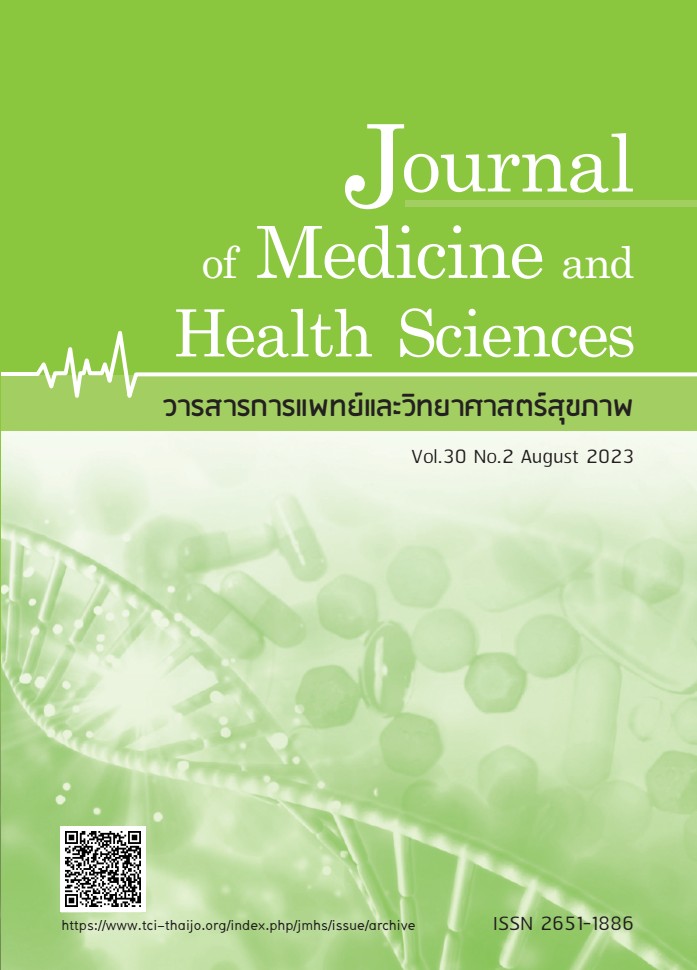Comparisons of the immediate radiographic results between wearing a custom-made thoracolumbosacral orthosis with and without a dynamic thoracic pad for a dolescent idiopathic scoliosis patients: A case series study
Keywords:
idiopathic scoliosis, dynamic thoracic pad, Cobb angle, apical translation, coronal decompensationAbstract
One of the most common pathologies in adolescents is adolescent idiopathic scoliosis (AIS). Spinal orthosis is a treatment option for delaying the progression of the curve. Based on the characteristics of the padding inside the orthosis, it can be divided into three groups: no padding, static padding, and dynamic padding. The Rosenberger brace is one type of spinal orthosis with a movable or dynamic pad; however, very few studies have been done on this design. The study fabricated a custom-made thoracolumbosacral orthosis (TLSO) based on the Boston principle concept with a movable thoracic pad following the Rosenberger brace concept. Therefore, the objective of the study was to compare the immediate radiographic results between wearing a custom-made TLSO with a dynamic thoracic pad (design 2) and without a dynamic thoracic pad (design 1) in AIS patients in terms of the Cobb angle, apical translation, and coronal decompensation reduction. This was a case-series study involving three AIS patients who were fitted with custom-made TLSO designs 1 and 2, and with an in-brace X-ray immediately taken for both interventions. The Cobb angle, apical translation, and coronal decompensation were measured and compared with the most recent out-of-brace X-ray. The results illustrated that the TLSO design 2 showed better results in terms of the Cobb angle reduction at both the thoracic and lumbar curves. For the apical translation reduction of TLSO design 2, it presented better results for participants 1 and 3 at the thoracic curve and at the lumbar curve for participants 1 and 2. In terms of coronal decompensation reduction, TLSO design 1 performed better than design 2 among participants 1 and 2. However, TSLO design 2 performed better in participant 3. Overall, both designs showed improvements in the Cobb angle, apical translation, and coronal decompensation. TLSO design 2 showed better results in reducing the Cobb angle and apical translation compared to TLSO design 1. The result of TLSO design 2 shows the high potential effectiveness of brace treatment. In the next step, a long-term study with a large group of scoliosis patients would be recommended, which would include assessing the quality of life of patients, as well as patient compliance.
References
Janicki JA, Alman B. Scoliosis: Review of diagnosis and treatment. Paediatr Child Health 2007;12:771-76.
Konieczny MR, Senyurt H, Krauspe R. Epidemiology of adolescent idiopathic scoliosis. J Child Orthop 2013;7:3-9.
Negrini S, Hresko TM, O'Brien JP, et al. Recommendations for research studies on treatment of idiopathic scoliosis: Consensus 2014 between SOSORT and SRS non-operative management committee. Scoliosis 2015;7:10.
Weinstein SL, Dolan LA, Wright JG, et al. Effects of Bracing in Adolescents with Idiopathic Scoliosis. N Engl J Med 2013;369:1512-21.
Ecker ML. "Adolescent idiopathic scoliosis: treatment with the Wilmington brace. A comparison of full-time and part-time use" (78-A: 1056-1062, July 1996). J Bone Joint Surg Am 1998;80:1083.
Ruffilli A, Fiore M, Barile F, et al. Evaluation of night-time bracing efficacy in the treatment of adolescent idiopathic scoliosis: a systematic review. Spine Deformity 2021;9:671-8.
Sattout A, Clin J, Cobetto N, et al. Biomechanical Assessment of Providence Nighttime Brace for the Treatment of Adolescent Idiopathic Scoliosis. Spine Deformity 2016;4:253-60.
Bohl DD, Telles CJ, Golinvaux NS, et al. Effectiveness of Providence Nighttime Bracing in Patients With Adolescent Idiopathic Scoliosis. Orthopedics 2014;37:e1085-90.
Lange JE, Steen H, Gunderson R, et al. Long-term results after Boston brace treatment in late-onset juvenile and adolescent idiopathic scoliosis. Scoliosis 2011;6:18.
Spoonamore MJ, Dolan LA and Weinstein SL. Use of the Rosenberger brace in the treatment of progressive adolescent idiopathic scoliosis. Spine (Phila Pa 1976) 2004;29:1458-64.
Wong MS, Li M, Ng B, et al. The effect of pressure pad location of spinal orthosis on the treatment of adolescent idiopathic scoliosis (AIS). Stud Health Technol Inform 2012;176:375-8.
Brox JI, Lange JE, Gunderson RB, et al. Good brace compliance reduced curve progression and surgical rates in patients with idiopathic scoliosis. Eur Spine J 2012;21:1957-63.
Wong MS, Mak AFT, Luk KDK, et al. Effectiveness and biomechanics of spinal orthoses in the treatment of adolescent idiopathic scoliosis (AIS). Prosthet Orthot Int 2000;24:148-62.
van den Hout J, van Rhijn L, van den Munckhof R, et al. Interface corrective force measurements in Boston brace treatment. Eur Spine J 2002;11:332-5.
Hermus J, Monteban P, Guldemond N, et al. Pressure measurements in a new TLSO with a dynamic thoracic brace pad for idiopathic scoliosis. Scoliosis 2009;4:42.
Landauer F, Wimmer C, Behensky H. Estimating the final outcome of brace treatment for idiopathic thoracic scoliosis at 6-month follow-up. Pediatr Rehabil 2003; 6: 201-207.
Weiss H-R, Rigo M. Expert-driven Chêneau applications: Description and in-brace corrections. Physiother Theory Pract 2011;27:61-7.
Downloads
Published
How to Cite
Issue
Section
License

This work is licensed under a Creative Commons Attribution-NonCommercial-NoDerivatives 4.0 International License.



